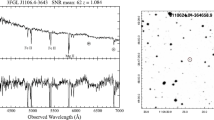Abstract
Despite the fact that blazars constitute the rarest class among active galactic nuclei (AGNs) they are the largest known population of associated \(\gamma\)-ray sources. Many of the \(\gamma\)-ray objects listed in the Fermi-Large Area Telescope Third Source catalog (3FGL) are classified as blazar candidates of uncertain type (BCUs), either because they show multifrequency behavior similar to blazars but lacking optical spectra in the literature, or because the quality of such spectra is too low to confirm their nature. Here we select, out of 585 BCUs in the 3FGL, 42 BCUs which we identify as probable blazars by their WISE infrared colors and which also have optical spectra that are available in the Sloan Digital Sky Survey (SDSS) and/or Six-Degree Field Galaxy Survey Database (6dFGS). We confirm the blazar nature of all of the sources. We furthermore conclude that 28 of them are BL Lacs, 8 are radio-loud quasars with flat radio spectrum and 6 are BL Lac whose emission is dominated by their host galaxy.





Similar content being viewed by others
References
Abdo, A.A., Ackermann, M., Ajello, M., et al.: Astrophys. J. Suppl. Ser. 188, 405 (2010)
Acero, F., Ackermann, M., Ajello, M., et al.: Astrophys. J. Suppl. Ser. 218, 23 (2015)
Ackermann, M., Ajello, M., Allafort, A., et al.: Astrophys. J. 753, 83 (2012)
Ackermann, M., et al.: J. Cosmol. Astropart. Phys. 09, 008 (2015a)
Ackermann, M., Ajello, M., Atwood, W.B., et al.: Astrophys. J. 810, 14 (2015b)
Ajello, M., Shaw, M.S., Romani, R.W., et al.: Astrophys. J. 751, 108 (2012)
Ajello, M., Romani, R.W., Gasparrini, D., et al.: Astrophys. J. 780, 73 (2014)
Ajello, M., Gasparrini, D., Sánchez-Conde, M., et al.: Astrophys. J. 800L, 27 (2015)
Alam, S., Albareti, F., Allende Prieto, C., et al.: Astrophys. J. Suppl. Ser. 219, 12 (2015)
Alvárez Crespo, N., Masetti, N., Landoni, M., et al.: Astron. J. 151, 32 (2016a)
Álvarez Crespo, N., Massaro, F., Milisavljevic, D., et al.: Astron. J. 151, 95 (2016b)
Arsioli, B., Fraga, B., Giommi, P., Padovani, P., Marrese, P.M.: Astron. Astrophys. 579A, 34 (2015)
Blandford, R.D., Rees, M.: Phys. Scr. 17, 265 (1978)
Cowperthwaite, P.S., Massaro, F., D’Abrusco, R., et al.: Astron. J. 146, 110 (2013)
Cutri, R.M., Wright, E.L., Conrow, T., et al.: wise.rept, 1C (2012)
D’Abrusco, R., Massaro, F., Ajello, M., et al.: Astrophys. J. 748, 68 (2012)
D’Abrusco, R., Massaro, F., Paggi, A., et al.: Astrophys. J. Suppl. Ser. 206, 12 (2013)
D’Abrusco, R., Massaro, F., Paggi, A., et al.: Astrophys. J. Suppl. Ser. 215, 14 (2014)
Jones, D.H., Saunders, W., Colless, M., et al.: Mon. Not. R. Astron. Soc. 355, 747 (2004)
Jones, D.H., Read, M.A., Saunders, W., et al.: Mon. Not. R. Astron. Soc. 399, 683 (2009)
Landoni, M., Massaro, F., Paggi, A., et al.: Astron. J. 149, 163 (2015)
Massaro, E., Giommi, P., Leto, C., et al.: Astron. Astrophys. 495, 691 (2009)
Massaro, F., D’Abrusco, R., Ajello, M., et al.: Astrophys. J. Lett. 740, L48 (2011)
Massaro, F., D’Abrusco, R., Tosti, G., et al.: Astrophys. J. 752, 61 (2012a)
Massaro, F., D’Abrusco, R., Tosti, G., et al.: Astrophys. J. 750, 138 (2012b)
Massaro, F., D’Abrusco, R., Paggi, A., et al.: Astrophys. J. Suppl. Ser. 206, 13 (2013a)
Massaro, F., D’Abrusco, R., Giroletti, M., et al.: Astrophys. J. Suppl. Ser. 207, 4 (2013b)
Massaro, F., D’Abrusco, R., Paggi, A., et al.: Astrophys. J. Suppl. Ser. 209, 10 (2013c)
Massaro, F., Giroletti, M., Paggi, A., et al.: Astrophys. J. Suppl. Ser. 208, 15 (2013d)
Massaro, F., Masetti, N., D’Abrusco, R., et al.: Astron. J. 148, 66 (2014)
Massaro, E., Maselli, A., Leto, C., et al.: Multifrequency Catalogue of Blazars, 5th edn. Aracne, Rome (2015a)
Massaro, F., Landoni, M., D’Abrusco, R., et al.: Astron. Astrophys. 575, 124 (2015b)
Nolan, P.L., Abdo, A.A., Ackermann, M., et al.: Astrophys. J. Suppl. Ser. 199, 31 (2012)
Paggi, A., Massaro, F., D’Abrusco, R., et al.: Astrophys. J. Suppl. Ser. 209, 9 (2013)
Paggi, A., Milisavljevic, D., Masetti, N., et al.: Astron. J. 147, 112 (2014)
Ricci, F., Massaro, F., Landoni, M., et al.: Astron. J. 149, 160 (2015)
Shaw, M.S., Romani, R.W., Cotter, G., et al.: Astrophys. J. 764, 135 (2013)
Stickel, M., Padovani, P., Urry, C.M., Fried, J.W., Kuehr, H.: Astrophys. J. 374, 431 (1991)
Taylor, M.B.: In: Shopbell, P., Britton, M., Ebert, R. (eds.) Astronomical Data Analysis Software and Systems XIV. ASP Conf. Ser., vol. 347, p. 29 (2005)
Titov, O., Jauncey, D.L., Johnston, H.M., et al.: Astron. J. 142, 165 (2011)
Vermeulen, R.C., Taylor, G.B.: Astron. J. 109, 1983 (1995)
Wright, E.L., Eisenhardt, P.R.M., Mainzer, A.K., et al.: Astron. J. 140, 1868 (2010)
Acknowledgements
This investigation is supported by the NASA grants NNX12AO97G and NNX13AP20G. The work by G. Tosti is supported by the ASI/INAF contract I/005/12/0. H.A. Smith acknowledges partial support from NASA/JPL grant RSA 1369566 and NASA grant NNX14. HOF was funded by a postdoctoral UNAM grant and is currently granted by a Cátedra CONACyT para Jóvenes Investigadores. V. Chavushyan acknowledges funding by CONACyT research grant 151494 (México). Part of this work is based on archival data, software or on-line services provided by the ASI Science Data Center. This research has made use of data obtained from the high-energy Astrophysics Science Archive Research Center (HEASARC) provided by NASA’s Goddard Space Flight Center; the SIMBAD database operated at CDS, Strasbourg, France; the NASA/IPAC Extragalactic Database (NED) operated by the Jet Propulsion Laboratory, California Institute of Technology, under contract with the National Aeronautics and Space Administration. This publication makes use of data products from the Wide-field Infrared Survey Explorer, which is a joint project of the University of California, Los Angeles, and the Jet Propulsion Laboratory/California Institute of Technology, funded by the National Aeronautics and Space Administration. Funding for the Sloan Digital Sky Survey IV has been provided by the Alfred P. Sloan Foundation, the U.S. Department of Energy Office of Science, and the Participating Institutions. SDSS-IV acknowledges support and resources from the Center for High-Performance Computing at the University of Utah. The SDSS web site is www.sdss.org. SDSS-IV is managed by the Astrophysical Research Consortium for the Participating Institutions of the SDSS Collaboration including the Brazilian Participation Group, the Carnegie Institution for Science, Carnegie Mellon University, the Chilean Participation Group, the French Participation Group, Harvard-Smithsonian Center for Astrophysics, Instituto de Astrofísica de Canarias, the Johns Hopkins University, Kavli Institute for the Physics and Mathematics of the Universe (IPMU)/University of Tokyo, Lawrence Berkeley National Laboratory, Leibniz Institut fur Astrophysik Potsdam (AIP), Max-Planck-Institut für Astronomie (MPIA Heidelberg), Max-Planck-Institut fur Astrophysik (MPA Garching), Max-Planck-Institut fur Extraterrestrische Physik (MPE), National Astronomical Observatory of China, New Mexico State University, New York University, University of Notre Dame, Observatorio Nacional/MCTI, the Ohio State University, Pennsylvania State University, Shanghai Astronomical Observatory, United Kingdom Participation Group, Universidad Nacional Autónoma de México, University of Arizona, University of Colorado Boulder, University of Oxford, University of Portsmouth, University of Utah, University of Virginia, University of Washington, University of Wisconsin, Vanderbilt University, and Yale University. TOPCATFootnote 2 (Taylor 2005) for the preparation and manipulation of the tabular data and the images.
Author information
Authors and Affiliations
Corresponding author
Rights and permissions
About this article
Cite this article
Álvarez Crespo, N., Massaro, F., D’Abrusco, R. et al. Optical archival spectra of blazar candidates of uncertain type in the 3rd Fermi Large Area Telescope Catalog. Astrophys Space Sci 361, 316 (2016). https://doi.org/10.1007/s10509-016-2902-1
Received:
Accepted:
Published:
DOI: https://doi.org/10.1007/s10509-016-2902-1




